Why My Writing Is Detected as AI — And What to Do About It
Why your human-written content might get flagged as AI — and what to do (calmly) when it does.
October 13, 2025
October 13, 2025

Ever had your writing flagged as AI-generated, even though you wrote every word yourself? You’re not alone. More writers, students, and freelancers are running into this issue as AI detection tools become more common. The issue is that they’re not always accurate. Getting a false positive can feel frustrating and unfair, especially when you’ve put in real effort.
In this article, I’ll explain why this happens, how AI detectors work, and what you can do to make sure your writing gets seen for what it is: human.
Why is my writing being flagged as AI?
Getting flagged by AI happens to the best of us, and it doesn’t mean you did something wrong. AI detection tools aren’t perfect, and even if you’re a skilled human writer, your work can trigger a false positive result.
This is especially true if your writing follows a clean structure or is very polished. This is something I’ve encountered in my copywriting work myself: following consistent formatting often trips online AI detection software up. It’s annoying, it’s not exactly motivating, and it’s a waste of time, having to rewrite something that I myself wrote because it got falsely flagged by an algorithm.
We've actually dealt with this from the client side when vetting writers for our content campaigns. The false positives usually happen when writers use overly clean sentence structures, repetitive transitional phrases, or that perfectly balanced "introduction-body-conclusion" format that AI loves. I've seen excellent human writers get flagged just because they were trying too hard to be "professional."
{{Damon Delcoro}}
What “flagged as AI” actually means
When an AI detection tool flags your writing, it doesn’t mean you copied it from somewhere on the internet or pasted it straight from ChatGPT. It means the tool thinks your writing matches patterns often found in AI content. This could be something like predictable phrasing or low variation in lengths of your sentences. I’ll explain it in more detail in the next section.
It’s important to note that having your writing “flagged as AI” is not plagiarism, and it doesn’t mean you’re in trouble. However, it can still raise red flags with clients, platforms, or professors (if you’re a student). I personally check my own writing with GPTZero before submitting it to a client to make sure there are no issues with false positives.
There is some debate about whether Google penalises AI-generated content by lowering it in search visibility. However, according to Google itself, using generative AI tools “does not determine the level of effort or Page Quality rating.” What gets penalised isn’t how content is made, but whether it’s lazy, low-value, or copy-pasted with no added substance.
How AI detectors work (and why they get it wrong)
So, let’s get into the theory of how AI detectors work, what they look for, and why they sometimes get it wrong.
What detection tools look for
AI detection tools analyse patterns in your writing to decide how “human” it sounds. There are two main factors here: perplexity and burstiness. These aren’t the only signals detection tools use, but they’re the easiest to understand. The rest often involve more technical pattern analysis.
- Perplexity is a measure of how predictable a piece of text is to a language model. Low perplexity means a piece of writing is very predictable, has basic sentence structures, or common phrasing. High perplexity entails varied word choice or unexpected structures. To put it simply, if your writing is very straightforward or sounds like something AI has seen a million times during training, it has low perplexity.
- Burstiness refers to the variation in sentence length and structure in a piece of writing. Regular human writing has high burstiness: a mix of short, long, and complex sentences. AI usually has low burstiness, which means more uniform sentence patterns.
Let’s have a look at a real-life example. I asked ChatGPT to generate a random piece of text on how to become a freelancer and ran it through GPTZero without any editing.
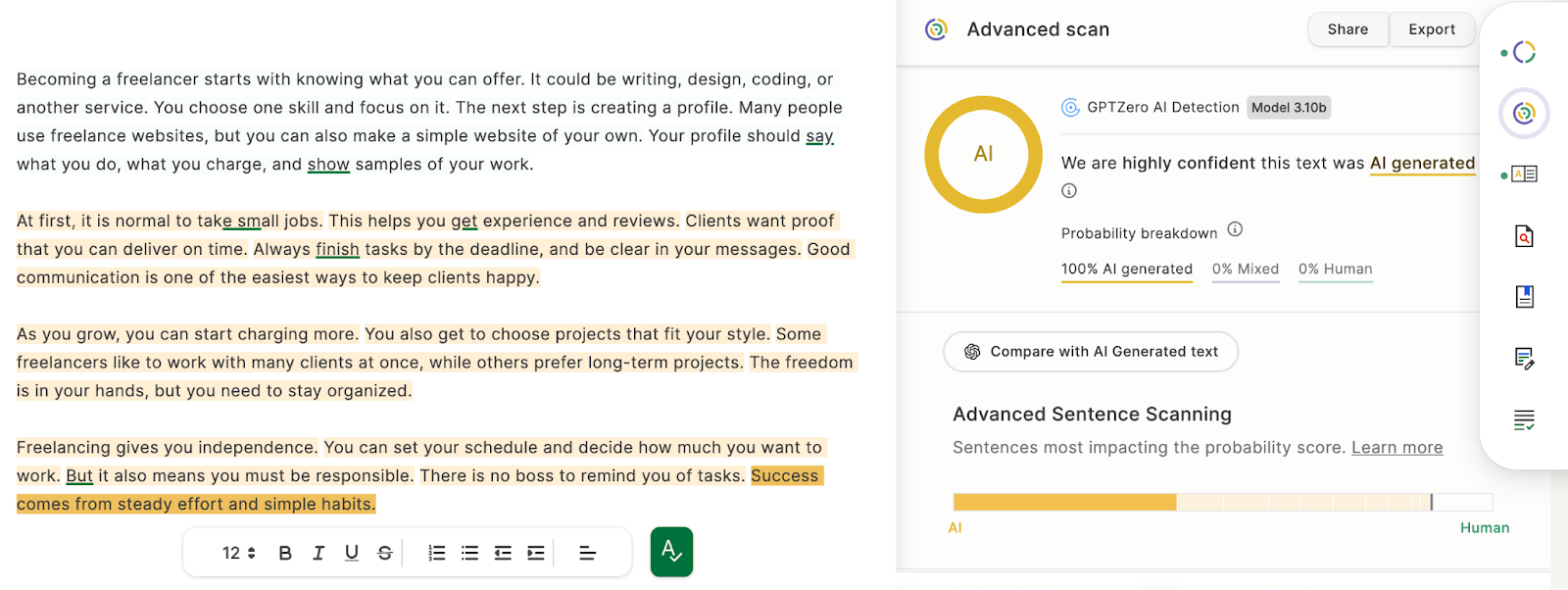
Predictably enough, it didn’t pass the AI check. Next, let’s select one of the sentences that was flagged as AI-generated to see what else matters to the algorithm, apart from perplexity and burstiness.
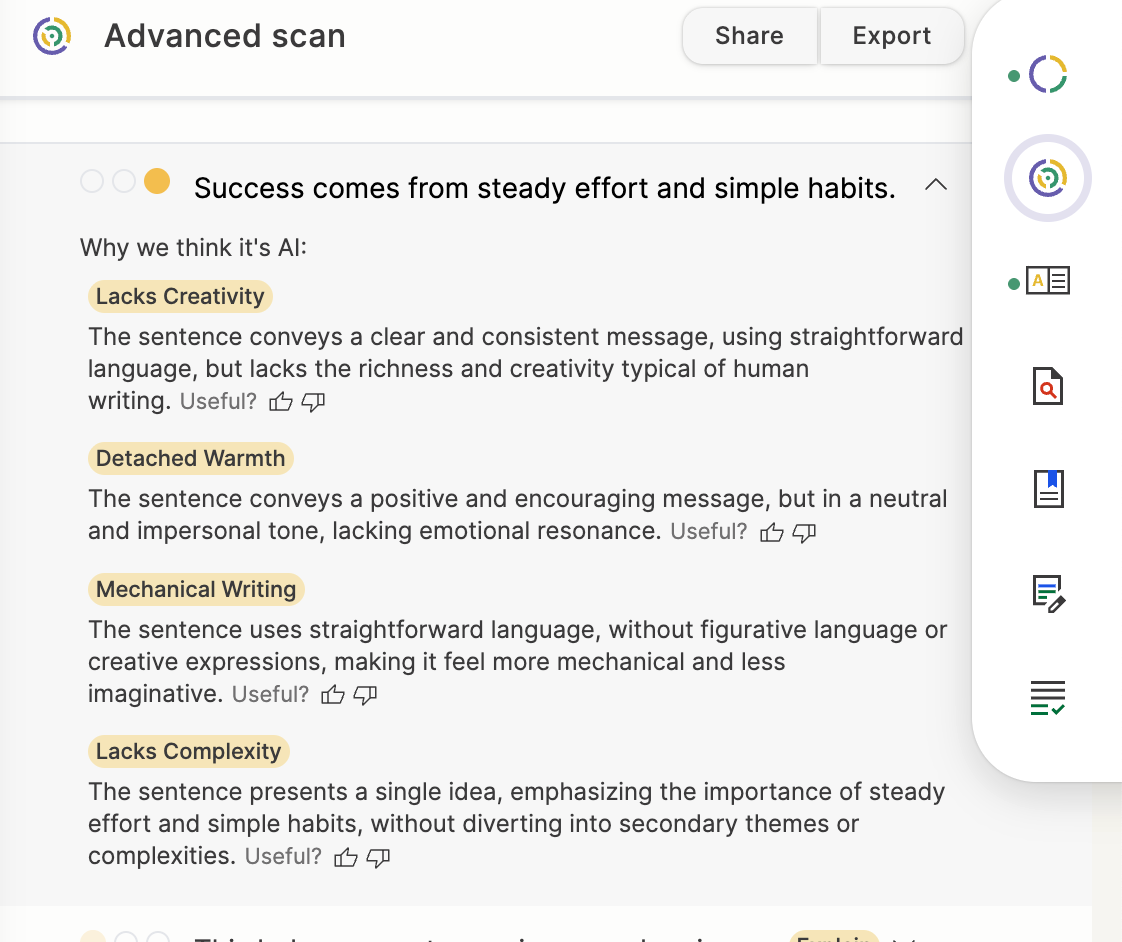
As you can see, your sentence structure and tone matter too. The more your writing feels structured, tidy, and emotionally flat, the more likely it is to trigger detection, even if you wrote it yourself. Other signals include things like how ideas transition between sentences (semantic flow), how often you repeat certain words, or whether your phrasing follows predictable logic patterns.
False positives are more common than you think
Even if your text is 100% human-written, an AI detector could still flag it. If this happens to you, you’re not alone. There are tonnes of people reporting this issue in online forums, especially in journalistic and academic contexts, where high polish and lack of errors are expected.
Even AI detectors themselves usually have a disclaimer on their websites suggesting that the nature of AI content is always changing, and that students shouldn’t be penalised if their texts are falsely positively flagged.
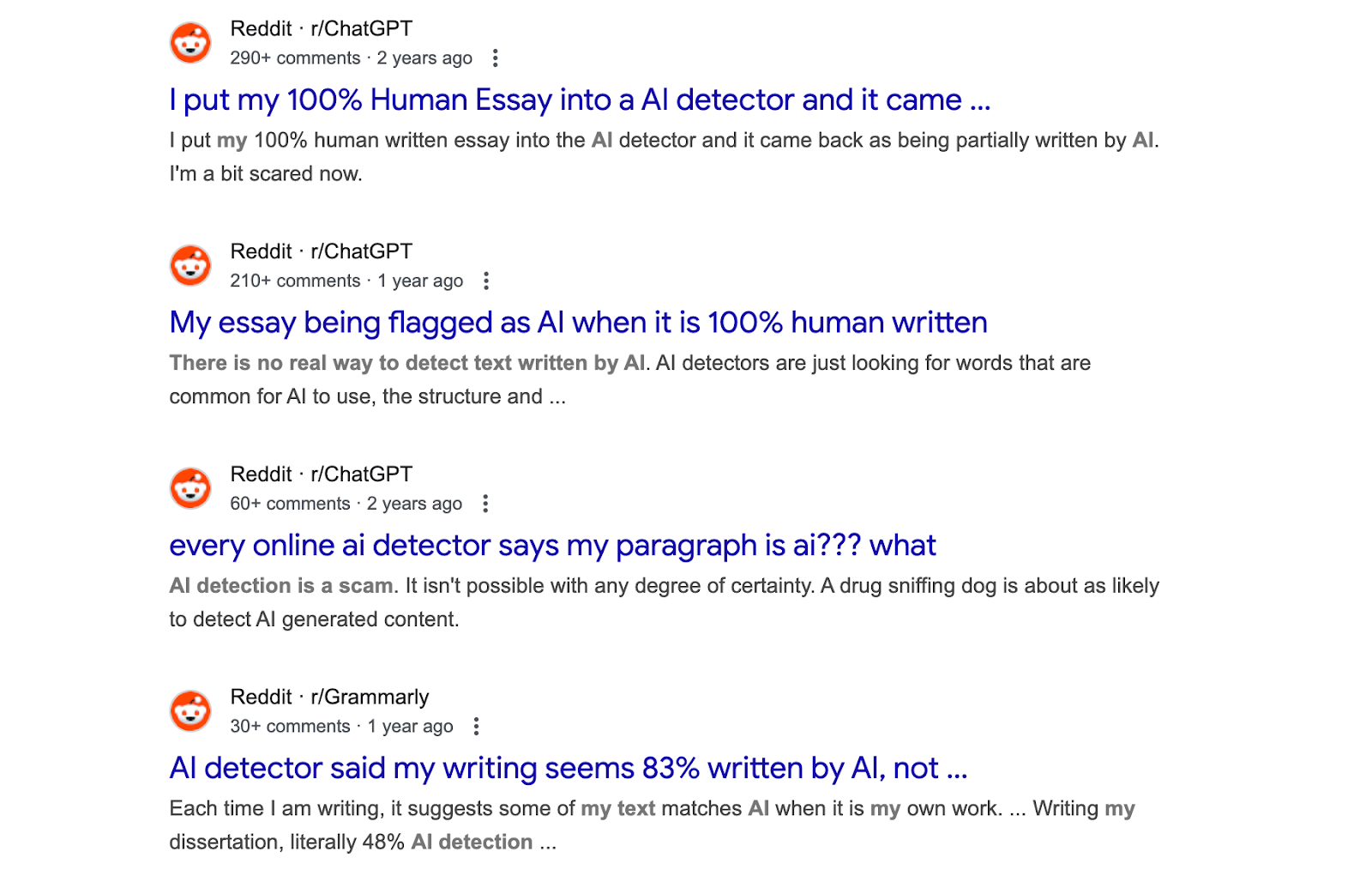
Another issue is the sheer number of AI detectors available online. They don’t always agree with each other: the same piece of text might be flagged as 80% AI by one tool and pass as fully human on another. This inconsistency only adds to the confusion.
I've turned into a bit of a nerd about this, to be honest. After I delivered a few long-form landing pages last spring, I ran the piece through four different detectors just to see how "robotic" I supposedly am. QuillBot, Copyleaks, and Writer.com all shrugged and said, "Yeah, 10-12 % AI, nothing to see here," but ZeroGPT promptly screamed, "99 % artificial!" I just sat there blinking at the screen, am I really that slick, or am I a complete hack?
{{Abdul Basith}}
I’ve shown you an example of an AI detector correctly identifying an AI-generated text as such. Here’s an example of a false flag. I ran a poem by Edgar Allan Poe, who died almost 170 years before the advent of the first text-generation software, through ZeroGPT.
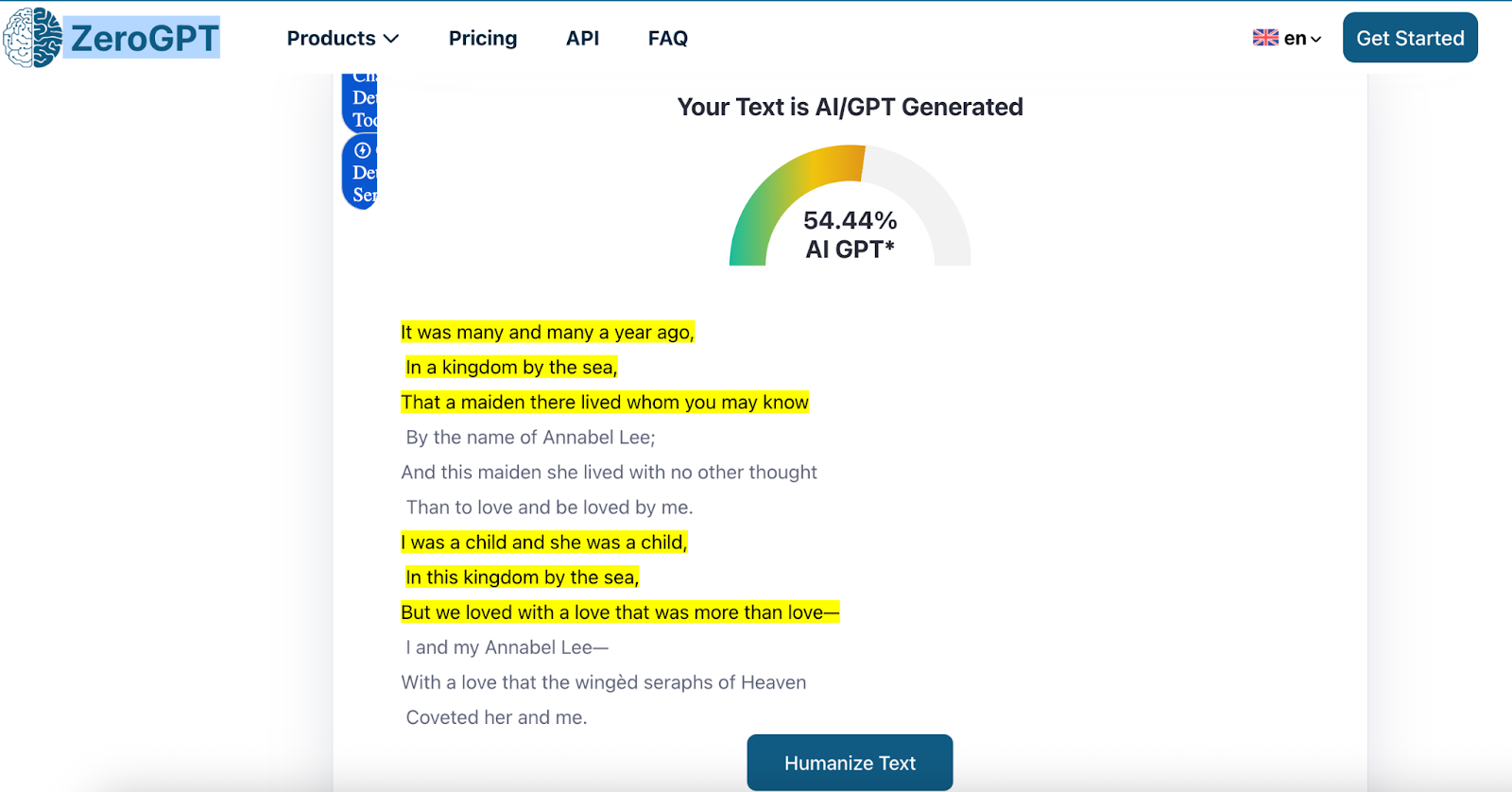
Common signs your writing might be flagged
Whether you’re a student, freelance writer, or just trying to avoid false positives, these are some common traits that raise suspicion.
Repetitive or predictable sentence structure
I’ve kind of touched upon this one already. AI-generated text often follows a rigid, formulaic rhythm. An example of this would be sentence after sentence beginning the same way, or paragraphs that all follow identical patterns. Humans can fall into this trap, too, especially when rushing or trying to write formally.
Brief-based structure
Copywriters will know what I’m talking about here. When you’re writing a piece to a content brief, especially one that’s packed with keywords, subheadings, or formatting requirements, your copy can start to resemble AI-generated text. That’s not because you’re doing anything wrong, but because you’re following a clear pattern.
To find the pattern, I repeatedly tested different narratives and styles, and finally I spotted the culprit. Turns out the piece was stuffed with the client's mandatory SEO phrases ("sustainable packaging solutions", "eco-friendly supply chain") repeated verbatim every 200 words. That repetition triggered the detectors.
{{Abdul Basith}}
Overly formal tone, lack of examples
AI-generated content often sounds stiff, detached, or overly polite. But that’s not unique to AI: humans can often write this way, too, especially in professional settings. Not every piece of writing allows for personality or warmth — if you’re writing a dissertation, you’re probably not going to throw in jokes or casual asides.
Still, when tone feels overly cautious or emotionally flat, AI detectors can mistake it for machine-generated. If you’re not using your personal voice in your writing or not including any real-life examples, you’re running the risk of sounding vague and robotic. Using a passive voice, avoiding contractions, or leaning on formal phrases like “it is important to note” can all make your writing feel artificial.
Before I start to work on a topic, I'll look for relevant contents like articles, insights, social media posts, angry Reddit threads, even TikTok rants from micro-influencers. I scribble the bits that make me sit up ("Blimey, that's useful") in my own messy English: no jargon. That rough draft stays loose, regional, sometimes half in swear words, sometimes in pure Yorkshire. Only after I've got the whole "story" in my own voice, I layer in the client's posh keywords and tidy the grammar. I've been writing this way since before ChatGPT existed, long before algorithms tried to mimic human tone.
{{Abdul Basith}}
Too polished, not enough mess
Some writing gets flagged because it’s too smooth. Now, I’m not suggesting that you submit a messy text full of errors. But when everything is hyper-curated, tidy, and exactly as expected, it can feel artificial (both to an AI detector and your client). Real human writing often includes odd details, slightly chaotic structure, or an unexpected turn of phrase. This is what algorithms can’t fake.
The red flag I've noticed in generic PR copy is when everything sounds "lifted" and "curated" without any real observation. I always include something specific and slightly catty that only someone who was actually there would notice – like mentioning which socialite's dress was two sizes too ambitious or how the canapes ran out before the honoree's speech. Those human moments of genuine detail are your insurance policy.
{{R. Couri Hay}}
Using AI tools for editing or support
If you know these AI tools are out there, you might be tempted to use them, if not for writing, then for editing or helping you plan the structure of your piece. Many human writers lean on tools like Grammarly, ChatGPT, or Quillbot to tighten up structure, fix grammar, or kickstart a draft. While that doesn’t make the end result AI-generated, it can sometimes result in a false flag.
How to avoid false AI flags
I’ve covered a few examples of things that can lead to your writing being falsely identified as AI. So, here’s a list of easy steps you can take to make sure you pass the check.
1. Break the pattern
If you notice that all of your sentences are the same length or have a similar structure, mix things up a little. This can be as easy as breaking long sentences into shorter ones, or switching from passive voice to active every now and then. Ask a rhetorical question. Start a sentence with “And,” if the context of your writing allows for it. The aim here is not to be chaotic, but to have a varied enough style.
2. Inject your personality
In 2025, when every other article is written with the assistance of ChatGPT, a human voice can be the most valuable thing a writer can bring to the table. Use words you’d actually say in real life, keep your signature way of saying stuff, then polish it to fit the context. You don’t need to try to be quirky for the sake of it, but your distinct tone is what sets you apart and gives readers a reason to come back.
Here's the thing about being flagged: my writing style is deliberately conversational with a wink – I use dashes, ellipses, and throw in theatrical asides that mirror how I'd tell these stories at a dinner party. When I profiled a Park Avenue gala, I wrote "the diamonds were blinding – literally, darling – and the champagne flowed faster than the gossip." That's not how AI writes. AI smooths everything out like bad Botox.
My advice? Write like you're texting your wittiest friend about the event, then polish it up just enough. If you can remove your voice and nothing changes, you've already lost to the robots – detector or not.
{{R. Couri Hay}}
3. Use specifics over generalities
The more specific you are, the harder it is to fake. AI can be good at summarising things or writing about something general, but it can’t write with specificity when it comes to real names, places, or opinions. Use actual case studies and real-life examples, client quotes, street names, and product quirks.
What works for our team is injecting specific client stories, local references, and occasional sentence fragments that match how people actually talk. When we write about a Delray Beach restaurant client, we mention the actual street corner and use phrases their customers would say – not generic marketing speak. AI detectors struggle with hyper-specific, conversational content that references real experiences.
{{Damon Delcoro}}
4. Don’t over-rely on AI tools
If you’re going to be using AI tools to fix your writing, don’t be surprised when it comes out sounding like a generic post on LinkedIn (and when an AI detector flags your writing as AI). Use them sparingly, especially when it comes to editing and rewriting.
What to do if your work was flagged
So, at this point in the article, it’s safe to say that these AI detection tools are not exactly reliable. But what should you do if your client or your editor raises concerns anyway?
Try light rewrites
Sometimes, a quick tweak is all it takes. Change your intro, rephrase a couple of transitions, or break up dense sections. Use the steps I outlined above to “humanise” your piece.
Show your work
There is evidence you can use to prove to your client your work is really yours, and not ChatGPT’s. If you’ve got Google Docs version history, screenshots of earlier drafts, or screen recordings of yourself editing, use them.
I screenshotted the Google-docs version history (time-stamped edits going back three days), sent them a screencast of me expanding one paragraph in real time, and offered to jump on a 10-minute call.
Advice: if a detector spooks a client, don't get defensive; offer to write a fresh paragraph on the spot while they watch. Nothing screams "human" like needing 30 seconds to think up a decent metaphor about compost.
{{Abdul Basith}}
Focus on the right metrics
If you’ve made edits, shared proof of authorship, and the content still raises concerns, it might be time to talk it through. Reassure your client that your goal is always quality, not shortcuts. If your client is dead-set on using AI detectors as part of their process, see if you can align on what really matters, like clarity, results, and audience engagement.
My honest take: AI detectors are terrible gatekeepers for freelance work. I'd rather judge a writer's work by results – does the content rank, does it convert, do real people engage with it? We've seen our client traffic increase 200%+ with content that probably would get flagged by some detector, but it works because it's written for humans first. If a client is using AI detectors as their main quality check, they're measuring the wrong thing.
{{Damon Delcoro}}
In conclusion
Yes, AI is everywhere. Unfortunately, that means that sometimes you’ll have to spend a little more time proving your work is 100% human than you should. But the real value of your writing lies in the thought and intention behind it, not the label some algorithm assigns. With a clear process, a calm approach, and a strong voice, you can make sure your work speaks for itself. May the AI detection odds be ever in your favour!
FAQ
Should I add typos or errors to “prove” I’m human?
Nope, don’t do this! You might trick an online AI detector, but it makes your writing worse as well as making you seem less professional.
Are AI detection tools actually reliable?
Not exactly. Use them as indicators rather than verdicts. Remember, algorithms and AI content change all the time. Different tools give wildly different results.
Can good human writing get flagged as AI?
For sure! If 19th-century poetry can get flagged as AI, polished, well-structured content can too. That’s why it helps to save your drafts, show your process, and stay calm if it happens.
We are here to ease your working routine
Whether you're freelancing or a full-time contractor, we simplify the working process, putting you in control.
Try it free




Freelancers often pay upfront. Learn the expense reimbursement process, what’s reimbursable, and how to avoid disputes.
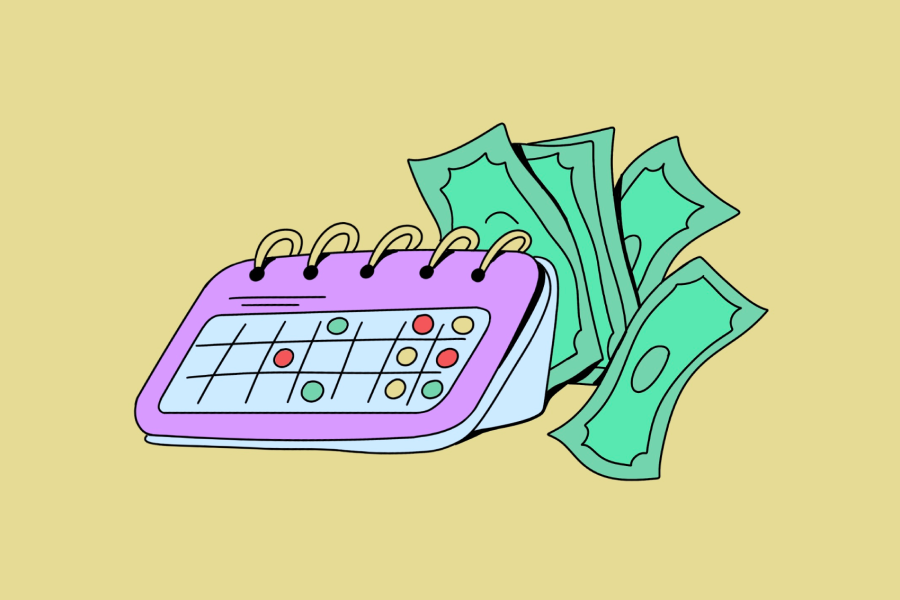
A simple guide to upfront payments: what they are, when to use them, how to explain them to clients, and what to do if they push back.

Discover how much a no-code developer makes, get insights about the career and its market, and get tips from specialists on how to get started.

.JPG)